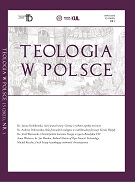Męka Jezusa na krzyżu ujawnia wszystkie poziomy mądrości ludzkiego ciała: potrzebę obecności innych, a przede wszystkim Boga, oraz zasadę dialogiczności. Jednocześnie Ukrzyżowany Zbawiciel przełamuje pokusę efektywności, gdyż moc krzyża nie polega na tym, że Chrystus zszedł z Niego, ale właśnie na tym, że na nim umarł. W taki sposób Chrystus dopełnił swoją wierność Ojcu i objawił Go jako swego Ojca, jako źródło swego życia. Oczywiście, wielu naocznych świadków domagało się od Jezusa innej formy uwierzytelnienia Jego posłannictwa i Synostwa Bożego.
Summary
THE ONE CRUCIFIED AND RISEN AS SON RECEIVED BY FATHER. A PERSONALISTIC CONTRIBUTION TO THE TRINITARIAN CONCEPTION OF THE ECONOMY OF SALVATION (2)
The inspiration to write this article is to a large extent the text of the not given conference no of late Fr. Eugeniusz Dutkiewicz SAC (†2002), one of the precursors of the hospice movement in Poland. The article consists of four points. The fi rst point shows that the suffering person can go the way of liberation from himself and rely on God. The human body has a dialogical structure, and thus the man by the conscious act of devotion can become a victim. Christ’s sacrifi ce should be understood that way. He offers a sacrifi ce from himself to the Father. It is a sacrifi ce of love, obedience and boundless devotion to the Father. The Father’s adoption of the Son’s sacrifi ce is testifi ed by the fact that “God raised him from the dead” (Rm 10: 9). For his friends, and through them to the whole world, the Risen Jesus is a revealer of love of the Triune God, Source, Redeemer and Giver of life.
Ostatnia aktualizacja: 25.01.2016, godz. 19:44 - Natalia Haniewska































